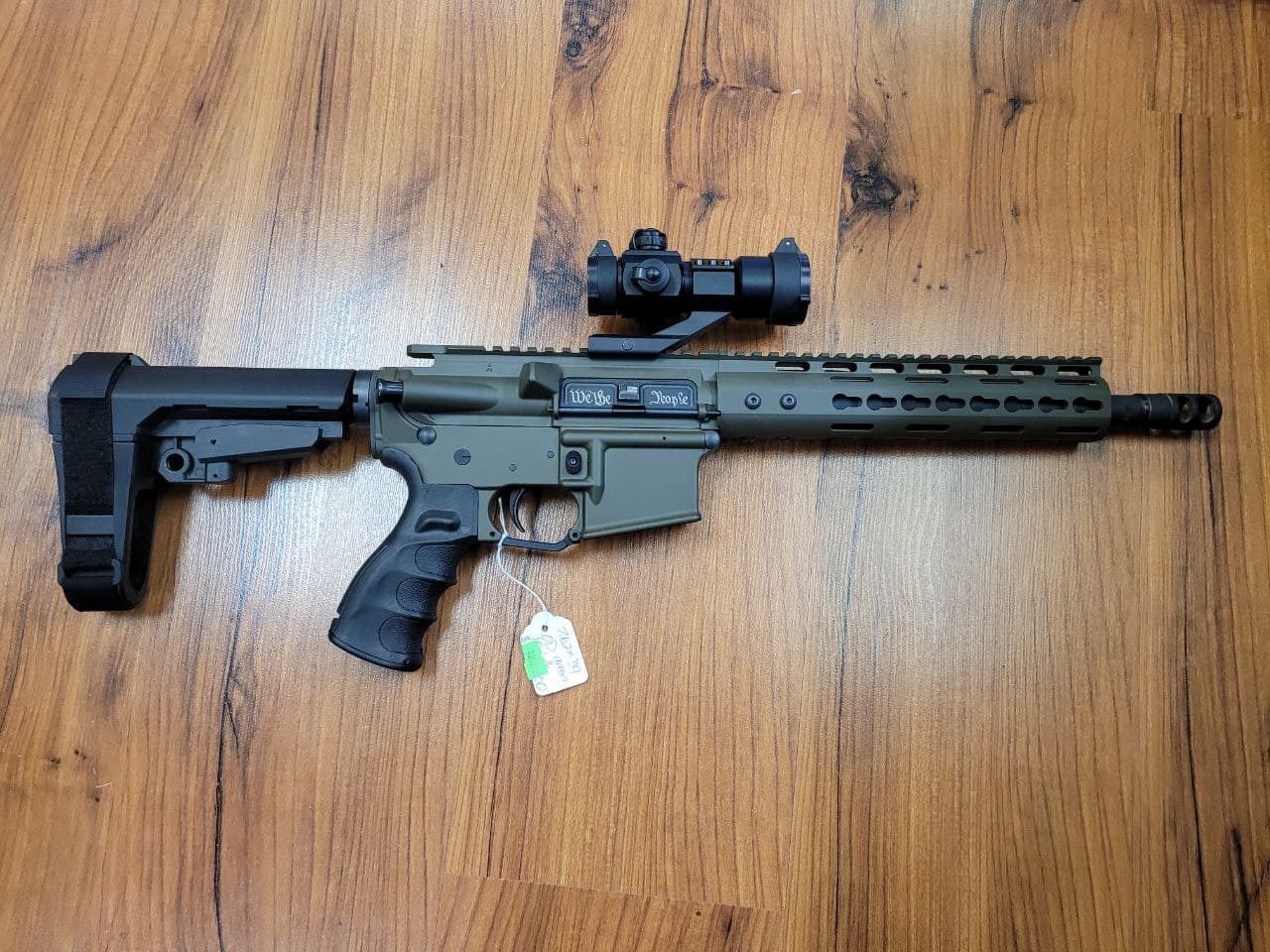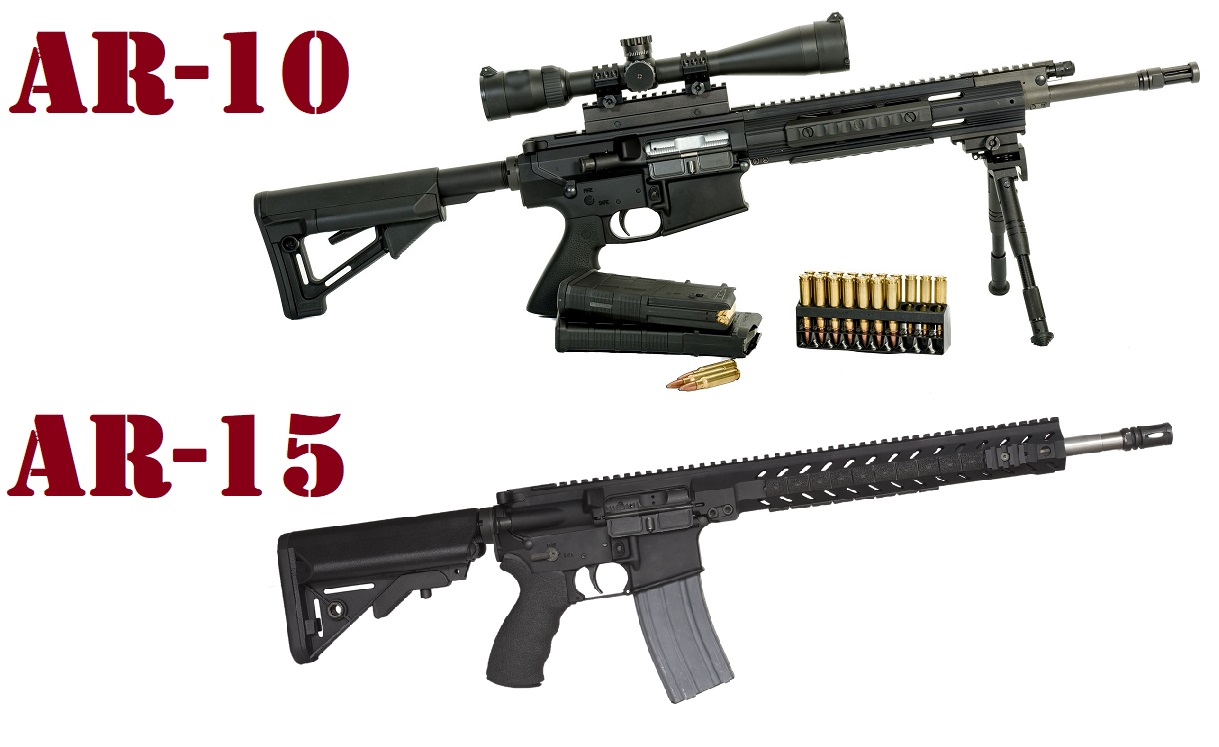Ar-10 Vs. Ar-15 - Two worthy carbines - AR-10 vs AR-15 - are among the most popular rifles in the United States. In this guide, we compare two modern sporting rifles and help you decide which one best fits your needs as a shooter.
Perhaps the best introduction to the AR-10 versus AR-15 debate is an oft-quoted joke that goes something like this.
Ar-10 Vs. Ar-15

This joke is pretty funny if you know anything about these oft-misunderstood modern sporting rifles. The mass panic over "assault rifles" has made most people at least moderately aware of the AR-15 (as a side note, the AR stands for "armlight rifle", not "assault rifle".)
Best Ar 15 Alternatives (5.56 Nato Semi Auto Rifles)
However, few people outside of the shooting culture truly understand the firearm. Even fewer can tell you the difference between an AR-15 and an AR-10.
In short, Armalite designed the AR-10 rifles to fire 7.62×51 ammo. They built the AR-15 to fire .223/5.56 ammo. The AR-10 is slightly larger (more powerful) while the AR-15 is lighter allowing most shooters to carry more ammo.
Of course, there are plenty of other details we're happy to dive into. Knowledge is power, so we'll take a look at the history of these two popular weapons. We will also explore their similarities and differences. Hopefully, this article helps you better understand what separates the AR-10 from the AR-15, as well as why you might choose one over the other.
Perhaps with a little education, we can help address the bad reputation unfairly stuck on these popular and useful firearms in this AR-10 vs AR-15 guide.
We Are Excited To Offer Our Ar10 Chambered In 308 Win. The Ar10 Is The Big Brother To The Ar15. The Ar10 And Ar15 Operate Much The Same. The Ar10 Is Growing
As you may have guessed, the AR-10 and AR-15 share the Armalite family tree. Armalite was founded in 1954 as a subdivision of Fairchild Engine and Airplane Corporation.
The AR-1, the eldest son of the Armalite line, was originally developed as a weapon for paratroopers. Lightweight and short-barreled, the AR-1 was perfect for soldiers leaping out of fully functional airplanes. Several other AR weapons followed, including the AR-7 survival rifle which is still in production today.
In the mid-1950s, Eugene Stoner, a former Navy and Army ordnance technician, joined the Armalite team. Stoner is responsible for the development of the original AR-10. Chambered in 7.62x51mm, the AR-10 had a lightweight receiver and integrated carrying handle.

However, the main development was the direct impingement system which injected gas directly into the receiver through a tube, which then spun the bolt carrier. This streamlined design reduces the overall weight of the AR-10 compared to rifles that use popular gas piston technology.
Ar 15 .223/5.56 16\
Armalite has presented this new design to the US government as a replacement candidate for the M1 Garand. Ultimately, the AR-10 lost out to Springfield Armory's T44, an updated M1 Garand design that would eventually become the M14.
The jungles of Vietnam have completely changed modern warfare. As the new M14s were pitted against enemy AK-47s, soldiers on the front lines regularly reported problems controlling their M14s in fire mode. Another major concern was that the ammunition was too heavy for the M14. The extra weight prevented American forces from carrying enough ammunition to gain fire superiority over enemies armed with the smaller 7.62x39mm cartridges used to load their AK-47s.
In an effort to overcome these difficulties, Army officials asked Armalite to develop a smaller version of their AR-10. The specific request was for a weapon chambered for the newly developed and lighter 5.56mm NATO round.
In response to the Army's request, Eugene Stoner, along with Armalite engineer Jim Sullivan, developed a new rifle chambered for the lighter 5.56mm NATO round. Thus was born the fresher and more popular little brother of the AR-10, the AR-15.
Ar 10 Compmag Gen.3
The new AR-15 design was tested by the US Continental Army Command. These light rifles were intended to replace the Browning Automatic Rifle, M1 Garand, M1 Carbine, Thompson Machine Gun and M3 "Grease Gun".
Despite performing well in every possible test category, Army Chief of Staff General Maxwell Taylor chose the M14 over the AR-15.
In response to this major setback, Armalite sold both the AR-10 and AR-15 models to the Colt Manufacturing Company in 1959. Colt immediately readied the AR-15 for mass production, which surely prevented the plan to hit rock bottom. From the weapons depot.

In 1960, the AR-15 got its first high-ranking military backer. At a July 4th party, Air Force Deputy Chief of Staff General Curtis LeMay was asked to shred watermelons off fences with an AR-15. He was an instant fan. Duly impressed with the weapon's accuracy and light weight, General LeMay ordered 8,500 AR-15s. This first order of AR-15s went to Air Force pilots and was intended to provide a combat option in the event of a shootdown over enemy territory.
Ar 15 Or Ar 10? A Build Junkie's Conundrum
In 1961, General Lamm (newly promoted to USAF Chief of Staff) ordered an additional 80,000 AR-15s for his airmen. He argued that the lighter recoil and smaller caliber were more effective than the somewhat bulky M14.
However, the Army continued to test the AR-15. They found the .223/5.56 AR-15 effective and much easier to fire efficiently than the 7.62mm M14 in service at the time. Army statistics show that 43% of shooters qualified in shooting trials while using the AR-15. In contrast, only 22% of qualified experts when shooting with the M14.
While common sense should make the AR-15 a shoe-in to replace the M14, senior military officers aren't always known for their common sense. General Maxwell Taylor, chairman of the Joint Chiefs of Staff, vetoed military use of the AR-15. His reasoning was that the military could not have two rifles chambered for different rounds in simultaneous service.
Meanwhile, the AK-47 continued to dominate the M14 in Vietnam. However, in the theater the U.S. Army Special Forces got their hands on the lightweight and easy-to-fire AR-15. In positive reviews sent to the military command, these units praised the combat effectiveness of the rifle.
If You Could Only Own One Gun, An Ar 15 Is A Great Choice Too
Due to positive reports from Special Forces, Secretary of Defense Robert McNamara has ordered extensive tests of the AR-15, AK-47 and M14. Surprisingly, the reported results favor M14. Since that didn't seem possible, given first-hand accounts of the weapons' battlefield performance, Secretary of Defense McNamara ordered an investigation into the testing procedures. This investigation found that the tests were heavily biased towards the M14.
An infamous example of improper tilt occurred during M14 accuracy tests, which pitted the M14 in a semi-automatic against a fully automatic AR-15. I'm no conspiracy theorist, but this makes me wonder who was lining the pockets of high-ranking military officers to keep the M14 in the hands of our soldiers. It's impossible to guess how many American lives might have been saved if the AR-15 had been adopted early in the conflict.
Fortunately, in 1963, the Department of Defense was notified that production of the M14 could not meet the demands of the military. Colt continued with its massive manufacturing capabilities and AR-15 rifles were supplied to all branches of the U.S. military. These rifles would later be redesignated as the M16.

Some values, such as price range, are general stats based on typically owned weapons. In many cases you can find some cheaper or more expensive options available out there.
Schmeisser Sp15 Straight Pull: The Ultramatch And M4fl Straight Pull Rifle Models Under Test
The most notable difference between these two rifles is the caliber. The AR-10 was originally chambered in 7.62×51 NATO, while the AR-15 was originally designed for 5.56mm cartridges.
Today these rifles are available in a variety of housings. You can find AR-10s chambered for long-action cartridges like the popular 6.5 Creedmoor, 6.5x47mm Lapua, and .243 Winchester. However, most AR-10s are still chambered in 7.62×51 NATO/.308 Winchester.
While the AR-15 is still typically chambered in 5.56mm/.223 Remington, it is also available for a long list of short-action centerfire cartridges, including the .300 AAC Blackout and the new .224 Valkyrie.
While the basic design is the same, the difference in caliber offerings also manifests itself in some minor differences between the AR-10 and AR-15. The main difference is in the rifling and ballistics. However, the AR-10's heavier ammunition naturally makes it heavier than a standard AR-15 (by about a pound and a half on average). Heavier ammunition also limits magazine capacity. The AR-10 typically has a capacity of 25 rounds compared to the AR-15's 30 rounds.
The Ar 10 And Ar 15 — What Are The Differences?
The AR-10 really excels at long range shooting. With heavy ammunition and a flat trajectory, the AR-10 has a long effective range (somewhere between 600 and 1,000 yards, depending on the shooter's proficiency).
For long-range target shooting, the AR-10 is a much better choice than the AR-15. Its serious long-range capability also makes the AR-10 a favorite of law enforcement snipers.
While the AR-10 may slow its heavier round a bit slower than the AR-15, that .308 caliber round packs a punch once it gets there. This makes the AR-10 a better choice for hunting, especially when shooting in freshly cut bean fields or open fields. The .308 Winchester is capable of bringing down any North American wild animal (except perhaps great bears) as well as most animals that roam the African continent.

The AR-15 is actually the smaller and more popular brother of the AR-10. Indeed, the AR-15 is the most popular weapons platform in the United States.
Ar 15 Size
Sig p365 tulster holster, sig p365 iwb holster, sig holsters p365, sig p365 sas holster, sig p365 xl holster, sig p365 hybrid holster, appendix holster sig p365, safariland holster sig p365, sig p365 belt holster, sig p365 holster, sig p365 purse holster, sig sauer p365 holster
0 Comments